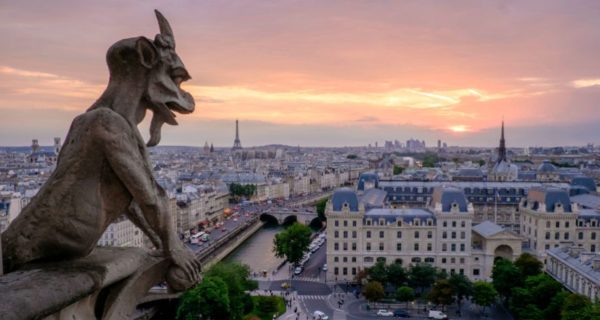Gothic Architecture has shaped our view of the Medieval period. It is my belief that church-building achieved its highest point during the Gothic period, and no Gothic structure would be complete without the classic Gothic gargoyles.
Technically speaking, gargoyles are decorative water-spouts, designed to divert rainwater from structures. The name either comes from the French word for throat, or from the name of a famous dragon, the Gargouille. The free-standing sculptures of monstrous beings adorning structures like Notre Dame are known as grotesques. Unlike true gargoyles, they have no structural function, other than decoration. Together, gargoyles and grotesques have defined how many people view medieval architecture, particularly churches. But why are such hideous beings found on hallowed ground? While no one knows exactly why gargoyles adorn medieval churches, there are a few guesses.
The medieval church wasn’t just an institution as we see it nowadays; the Church was the very center of medieval life. It was the glue that held civilization together. As the monk Athalstan said in the TV series Vikings, “Without the Word of God, there is only darkness”. The gargoyles may have represented the darkness lurking outside the safety of the church’s walls. The ugly, monstrous creatures imagined by medieval artisans stood as a warning to those who ventured outside the church. Another possibility is that the gargoyles represented the exact opposite; the gargoyles may have been meant to frighten off the demons lurking outside. The mythical Gargouille was said to be so hideous that he frightened the devil himself.
Another possibility is that the gargoyles represented medieval humor. Mocking the devil is a longstanding tradition. As Martin Luther said “The best way to drive out the devil, if he will not yield to texts of Scripture, is to jeer and flout him for he cannot bear scorn.” The often comical or whimsical features of gargoyles and grotesques lends itself to humor. Such mockery would’ve surely driven the devil back. A related theory may be that the gargoyles and grotesques are meant to represent the pagan gods and monsters defeated and replaced by Christianity, perhaps as a message to newly converted pagans.
In the artistic splendor of Gothic architecture, perhaps the gargoyles stand as a warning to modern men of the tendency of the human soul to regress into ugliness. Looking at the past century of artwork, it is easy for me to see that the medievals may have had a point, if that was their point. Once art had become “unhitched” from religion, it quickly descended into chaos. It seems modern art has had a love affair with ugliness, producing works that completely defy any logic or human reason. We’ve gone from producing magnificent cathedrals and stained glass windows, to featureless minimalist boxes, and tossing paint on canvas with no rhyme or reason. We’ve gone from a little lower than the angels, to little more than beasts. Having tossed out all objective standards of beauty, ugliness reigns supreme. Stones can talk, and they’re speaking to us now.

